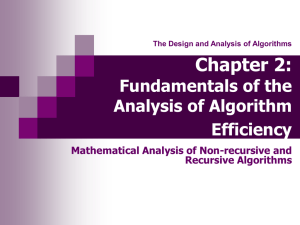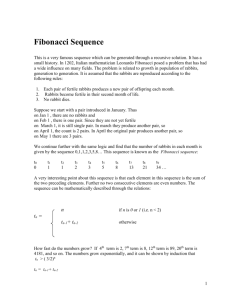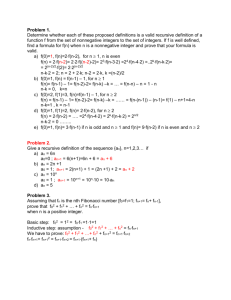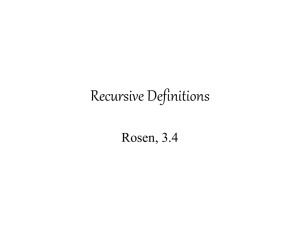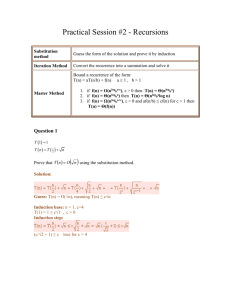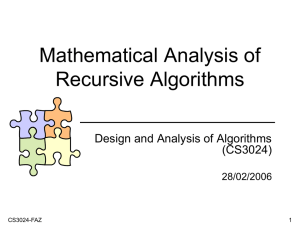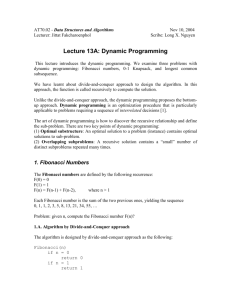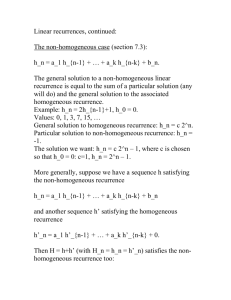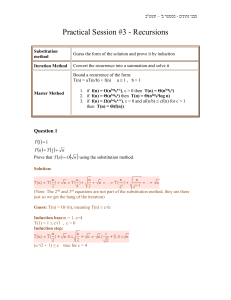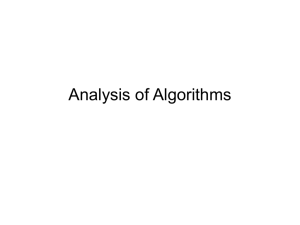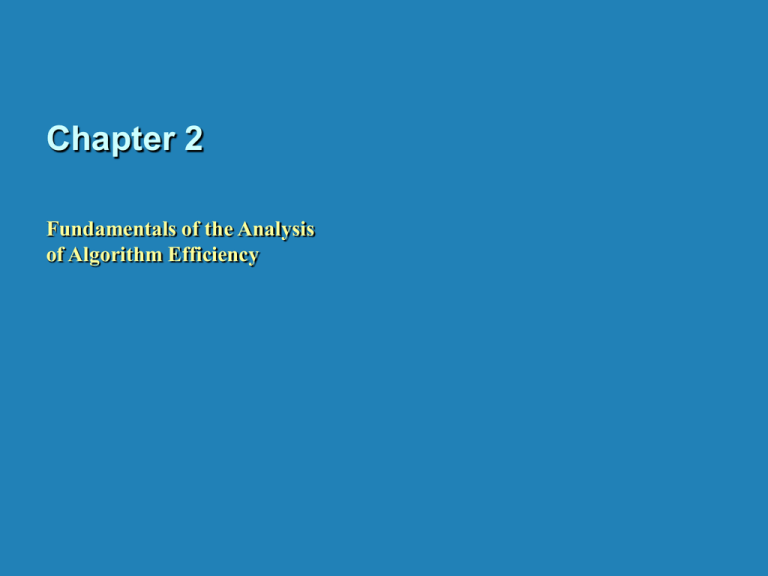
Chapter 2
Fundamentals of the Analysis
of Algorithm Efficiency
Analysis of algorithms
Issues:
•
•
•
•
correctness
time efficiency
space efficiency
optimality
Approaches:
• theoretical analysis
• empirical analysis
Theoretical analysis of time efficiency
Time efficiency is analyzed by determining the number of
repetitions of the basic operation as a function of input size
Basic operation: the operation that contributes most
towards the running time of the algorithm
input size
T(n) ≈ copC(n)
running time
execution time
for basic operation
Number of times
basic operation is
executed
Input size and basic operation examples
Problem
Input size measure
Basic operation
Searching for key in a
list of n items
Number of list’s items,
i.e. n
Key comparison
Multiplication of two
matrices
Matrix dimensions or
total number of elements
Multiplication of two
numbers
Checking primality of
a given integer n
n’size = number of digits
Division
(in binary representation)
Typical graph problem
#vertices and/or edges
Visiting a vertex or
traversing an edge
Empirical analysis of time efficiency
Select a specific (typical) sample of inputs
Use physical unit of time (e.g., milliseconds)
or
Count actual number of basic operation’s executions
Analyze the empirical data
Best-case, average-case, worst-case
For some algorithms efficiency depends on form of input:
Worst case: Cworst(n) – maximum over inputs of size n
Best case:
Average case: Cavg(n) – “average” over inputs of size n
Cbest(n) – minimum over inputs of size n
• Number of times the basic operation will be executed on typical input
• NOT the average of worst and best case
• Expected number of basic operations considered as a random variable
under some assumption about the probability distribution of all
possible inputs
Example: Sequential search
Worst case
Best case
Average case
Types of formulas for basic operation’s count
Exact formula
e.g., C(n) = n(n-1)/2
Formula indicating order of growth with specific
multiplicative constant
e.g., C(n) ≈ 0.5 n2
Formula indicating order of growth with unknown
multiplicative constant
e.g., C(n) ≈ cn2
Order of growth
Most important: Order of growth within a constant multiple
as n→∞
Example:
• How much faster will algorithm run on computer that is
twice as fast?
• How much longer does it take to solve problem of double
input size?
Values of some important functions as n
Asymptotic order of growth
A way of comparing functions that ignores constant factors and
small input sizes
O(g(n)): class of functions f(n) that grow no faster than g(n)
Θ(g(n)): class of functions f(n) that grow at same rate as g(n)
Ω(g(n)): class of functions f(n) that grow at least as fast as g(n)
Big-oh
Big-omega
Big-theta
Establishing order of growth using the definition
Definition: f(n) is in O(g(n)) if order of growth of f(n) ≤ order
of growth of g(n) (within constant multiple),
i.e., there exist positive constant c and non-negative integer
n0 such that
f(n) ≤ c g(n) for every n ≥ n0
Examples:
10n2 is O(n2)
5n+20 is O(n)
Some properties of asymptotic order of growth
f(n) O(f(n))
f(n) O(g(n)) iff g(n) (f(n))
If f (n) O(g (n)) and g(n) O(h(n)) , then f(n) O(h(n))
Note similarity with a ≤ b
If f1(n) O(g1(n)) and f2(n) O(g2(n)) , then
f1(n) + f2(n) O(max{g1(n), g2(n)})
Establishing order of growth using limits
0 order of growth of T(n) < order of growth of g(n)
c > 0 order of growth of T(n) = order of growth of g(n)
lim T(n)/g(n) =
n→∞
∞ order of growth of T(n) > order of growth of g(n)
Examples:
• 10n
vs.
n2
• n(n+1)/2
vs.
n2
L’Hôpital’s rule and Stirling’s formula
L’Hôpital’s rule: If limn f(n) = limn g(n) = and
the derivatives f´, g´ exist, then
lim
n
f(n)
g(n)
=
Example: log n vs. n
Stirling’s formula: n! (2n)1/2 (n/e)n
Example: 2n vs. n!
lim
n
f ´(n)
g ´(n)
Orders of growth of some important functions
All logarithmic functions loga n belong to the same class
(log n) no matter what the logarithm’s base a > 1 is
All polynomials of the same degree k belong to the same class:
aknk + ak-1nk-1 + … + a0 (nk)
Exponential functions an have different orders of growth for
different a’s
order log n < order n (>0) < order an < order n! < order nn
Basic asymptotic efficiency classes
1
constant
log n
logarithmic
n
linear
n log n
n-log-n
n2
quadratic
n3
cubic
2n
exponential
n!
factorial
Time efficiency of nonrecursive algorithms
General Plan for Analysis
Decide on parameter n indicating input size
Identify algorithm’s basic operation
Determine worst, average, and best cases for input of size n
Set up a sum for the number of times the basic operation is
executed
Simplify the sum using standard formulas and rules (see
Appendix A)
Useful summation formulas and rules
liu1 = 1+1+…+1 = u - l + 1
In particular, liu1 = n - 1 + 1 = n (n)
1in i = 1+2+…+n = n(n+1)/2 n2/2 (n2)
1in i2 = 12+22+…+n2 = n(n+1)(2n+1)/6 n3/3 (n3)
0in ai = 1 + a +…+ an = (an+1 - 1)/(a - 1) for any a 1
In particular, 0in 2i = 20 + 21 +…+ 2n = 2n+1 - 1 (2n )
(ai ± bi ) = ai ± bi
cai = cai
liuai = limai + m+1iuai
Example 1: Maximum element
Example 2: Element uniqueness problem
Example 3: Matrix multiplication
Example 5: Counting binary digits
It cannot be investigated the way the previous examples are.
Plan for Analysis of Recursive Algorithms
Decide on a parameter indicating an input’s size.
Identify the algorithm’s basic operation.
Check whether the number of times the basic op. is executed
may vary on different inputs of the same size. (If it may, the
worst, average, and best cases must be investigated
separately.)
Set up a recurrence relation with an appropriate initial
condition expressing the number of times the basic op. is
executed.
Solve the recurrence (or, at the very least, establish its
solution’s order of growth) by backward substitutions or
another method.
Example 1: Recursive evaluation of n!
Definition: n ! = 1 2 … (n-1) n for n ≥ 1 and 0! = 1
Recursive definition of n!: F(n) = F(n-1) n for n ≥ 1 and
F(0) = 1
Size:
Basic operation:
Recurrence relation:
Solving the recurrence for M(n)
M(n) = M(n-1) + 1, M(0) = 0
Example 2: The Tower of Hanoi Puzzle
1
3
2
Recurrence for number of moves:
Solving recurrence for number of moves
M(n) = 2M(n-1) + 1, M(1) = 1
Tree of calls for the Tower of Hanoi Puzzle
n
n-1
n-1
n-2
2
1
...
1
n-2
n-2
...
...
2
1
n-2
1
2
1
2
1
1
1
Example 3: Counting #bits
Fibonacci numbers
The Fibonacci numbers:
0, 1, 1, 2, 3, 5, 8, 13, 21, …
The Fibonacci recurrence:
F(n) = F(n-1) + F(n-2)
F(0) = 0
F(1) = 1
General 2nd order linear homogeneous recurrence with
constant coefficients:
aX(n) + bX(n-1) + cX(n-2) = 0
Solving aX(n) + bX(n-1) + cX(n-2) = 0
Set up the characteristic equation (quadratic)
ar2 + br + c = 0
Solve to obtain roots r1 and r2
General solution to the recurrence
if r1 and r2 are two distinct real roots: X(n) = αr1n + βr2n
if r1 = r2 = r are two equal real roots: X(n) = αrn + βnr n
Particular solution can be found by using initial conditions
Application to the Fibonacci numbers
F(n) = F(n-1) + F(n-2) or F(n) - F(n-1) - F(n-2) = 0
Characteristic equation:
Roots of the characteristic equation:
General solution to the recurrence:
Particular solution for F(0) =0, F(1)=1:
Computing Fibonacci numbers
1.
Definition-based recursive algorithm
2.
Nonrecursive definition-based algorithm
3.
Explicit formula algorithm
4.
Logarithmic algorithm based on formula:
F(n-1) F(n)
0 1 n
=
1 1
F(n) F(n+1)
for n≥1, assuming an efficient way of computing matrix powers.
Empirical Analysis of Algorithms
General Plan for Empirical Analysis of Algorithms Time
Efficiency
1.
2.
3.
4.
5.
6.
7.
Understand the experiment’s purpose
Decide on the efficiency metric M to be measured and the
measurement unit (an operation’s count versus a time unit)
Decide on characteristics of the input sample (its range, size, and so
on)
Prepare a program implementing the algorithm (or algorithms) for
the experimentation
Generate a sample of inputs
Run the algorithm (or algorithms) on the sample’s inputs and record
the data observed
Analyze the data obtained
Algorithm Visualization
Defined as the use of images to convey some useful
information about algorithms
• Can be a visual illustration of an algorithm’s operation,
• Of its performance on different kinds of inputs, or
• Its execution speed versus that of other algorithms for the same
problem
Uses graphic elements (points, line segments, two- or threedimensional bars, and so on) to represent some interesting
events in an algorithm’s operation
Can be
• Static through a series of still images
• Animation showing a continuous, movie-like presentation
Sorting
http://www.cs.rit.edu/~atk/Java/Sorting/sorting.html
Copyright © 2007 Pearson Addison-Wesley. All rights reserved.
A. Levitin “Introduction to the Design & Analysis of Algorithms,” 2nd ed., Ch. 2
2-39


